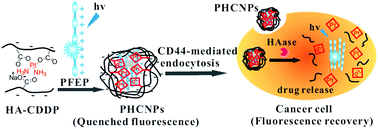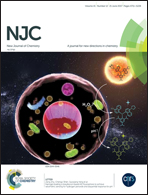Self-assembled nanoparticles based on a cationic conjugated polymer/hyaluronan–cisplatin complex as a multifunctional platform for simultaneous tumor-targeting cell imaging and drug delivery†
Abstract
Multifunctional therapeutic systems that can realize simultaneous tumor-targeting imaging and drug delivery are highly desired to improve the therapeutic efficacy of conventional chemotherapy. Herein, we described a novel nanoparticle system prepared by electrostatic and hydrophobic self-assembly of a cationic conjugated polymer, PFEP, and anionic hyaluronan (HA) conjugated with the model anticancer drug cisplatin (CDDP). PFEP exhibited high fluorescence quantum yield, good photostability and low cytotoxity to meet the essential requests for cell imaging. HA is a natural glycosaminoglycan that possesses high specific affinity for the CD44 receptor overexpressed on surfaces of various cancer cells. The 20.2% CDDP-loaded PFEP/HA–CDDP complex nanoparticles (PHCNPs) were observed to comprise a compact hydrophobic inner core and a hydrophilic HA shell, and exhibit smaller size and better dispersity in aqueous solution than HA–CDDP nanoparticles (HCNPs) with the same drug loading content. Moreover, the fluorescence of PHCNPs was almost quenched due to the increased torsional conformation and aggregation of PFEP in the compact inner core. After PHCNPs were taken up by the target cancer cells through the specific HA–CD44 binding, HA was hydrolyzed by overexpressed hyaluronidase (HAase) in the cancer cells, which destroyed the nanoparticles, resulting in fluorescence recovery from PFEP and the release of CDDP. In vitro drug release studies also confirmed the HAase-promoted sustained CDDP release of PHCNPs. Therefore, tumor-targeting drug release and distribution in cells can be monitored by the recovered fluorescence signals. Furthermore, in vitro cytotoxicity studies demonstrated that the PHCNPs showed evident selective cytotoxicity, thereby leading to reduced side effects in normal cells. Therefore, the studies of conjugated polymers in multifunctional therapeutic system may offer a promising approach for improving the therapeutic efficacy of chemotherapy.



 Please wait while we load your content...
Please wait while we load your content...